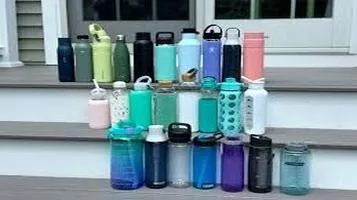The Ultimate Guide to Water Bottles: A Comprehensive Review
Water bottles are essential, portable containers designed for storing and transporting water and other beverages. Made from a variety of materials such as plastic, stainless steel, glass, and aluminum, they cater to diverse needs and preferences. Reusable water bottles are an eco-friendly alternative to single-use plastic bottles, significantly reducing environmental waste. They are available in numerous sizes, colors, and designs, often featuring convenient elements like insulated walls to maintain temperature, leak-proof lids, and easy-to-carry handles or straps. Many bottles also come with built-in filters to ensure clean drinking water on the go. Whether for sports, travel, work, or daily hydration, water bottles offer a practical and sustainable solution for staying refreshed and healthy.

In today's health-conscious and environmentally aware world, water bottles have become more than just containers to hold liquids; they are a statement of our lifestyle choices. From reducing plastic waste to ensuring we stay hydrated throughout the day, water bottles now come in a variety of shapes, sizes, and materials. This comprehensive review covers the most popular types of water bottles, their pros and cons, and what makes each unique.
Types of Water Bottles
1. Plastic Water Bottles
- Pros: Lightweight, affordable, and available in a myriad of designs and colors. Many are made with BPA-free plastic, which is safer for health.
- Cons: Even BPA-free plastics can sometimes leach chemicals over time, especially when exposed to heat. They also tend to retain flavors and odors.
- Noteworthy Brands: Nalgene and CamelBak are well-known for their durable and versatile plastic water bottles.
2. Stainless Steel Water Bottles
- Pros: Highly durable, often insulated to keep beverages hot or cold for extended periods, and do not retain flavors or odors.
- Cons: Heavier than plastic bottles and usually more expensive. They can also dent if dropped.
- Noteworthy Brands: Hydro Flask and YETI are leaders in the market, known for their high-quality, insulated stainless steel bottles.
3. Glass Water Bottles
- Pros: Do not retain flavors or odors, and are often considered the healthiest option as they do not leach chemicals. They are also fully recyclable.
- Cons: Fragile and can break easily. They are also heavier than plastic and some stainless steel bottles.
- Noteworthy Brands: Lifefactory and Soma offer stylish and durable glass bottles often encased in silicone sleeves for added protection.
4. Collapsible Water Bottles
- Pros: Extremely portable as they can be rolled up or collapsed when empty, making them ideal for travel and outdoor activities.
- Cons: Generally less durable and can be more difficult to clean. They also might not keep beverages at a stable temperature.
- Noteworthy Brands: Vapur and Nomader provide innovative designs that cater to the needs of adventurers and travelers.
Key Features to Consider
1. Insulation: Double-walled, vacuum-insulated bottles are excellent for maintaining the temperature of your drink, whether hot or cold. This feature is most commonly found in stainless steel bottles.
2. Capacity: Water bottles come in various sizes, from small 12-ounce bottles to large 64-ounce models. Your choice should depend on your daily hydration needs and how often you are able to refill the bottle.
3. Mouth Opening: Wide-mouth bottles are easier to clean and allow for the addition of ice cubes or fruit slices. Narrow-mouth bottles are easier to drink from on-the-go but can be harder to clean.
4. Ease of Cleaning: Bottles with fewer parts and wider openings are generally easier to clean. Some are dishwasher safe, which adds convenience.
5. Leak-Proof Design: A good water bottle should have a reliable sealing mechanism to prevent leaks. Look for bottles with sturdy lids and seals.
6. Material Safety: Ensure that the bottle is BPA-free and made of food-grade materials to avoid any health risks.
Environmental Impact
One of the major advantages of using a reusable water bottle is its positive impact on the environment. Single-use plastic bottles are a significant contributor to plastic pollution, and switching to a reusable option can drastically reduce your carbon footprint. Stainless steel and glass bottles are especially beneficial as they are long-lasting and recyclable.
Personal Experience and Recommendations
As someone who has tested various water bottles over the years, I have found that each type has its own unique benefits suited to different lifestyles. For instance, my Hydro Flask has been indispensable during long hikes and day trips, keeping my water ice-cold even in the heat. On the other hand, my glass Lifefactory bottle is my go-to for a day at the office, offering a clean taste and an aesthetically pleasing design.
For those who travel frequently, collapsible bottles like the Vapur have proven to be incredibly convenient. Their ability to save space when empty is unmatched, although they might not be as durable or insulating as their stainless steel counterparts.
For everyday use, I find plastic bottles like those from CamelBak to be lightweight and practical, especially for activities like biking or gym workouts. However, they do require more frequent cleaning to avoid any lingering odors or flavors.
Conclusion
Choosing the right water bottle involves considering various factors including material, insulation, capacity, and ease of cleaning. Whether you prioritize durability, portability, or environmental impact, there is a water bottle out there to meet your needs. Investing in a high-quality, reusable water bottle not only supports a healthier lifestyle but also contributes to a more sustainable planet. So, make an informed choice and stay hydrated!






